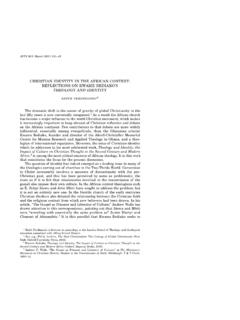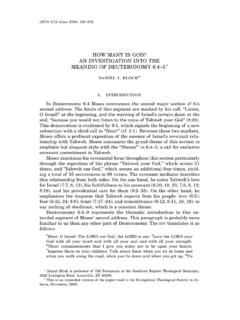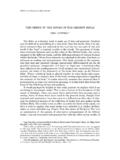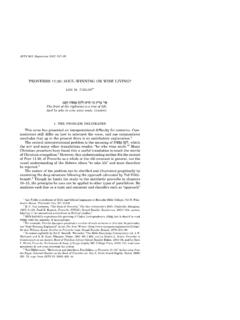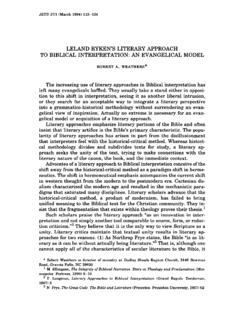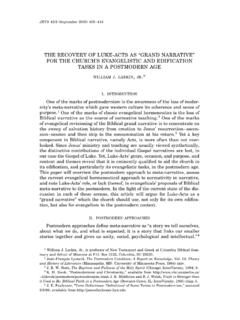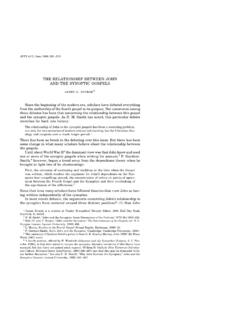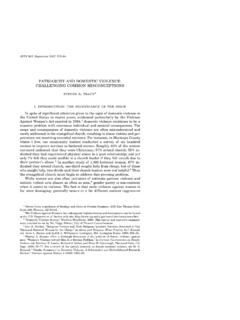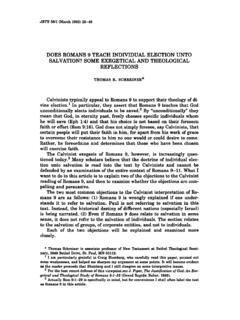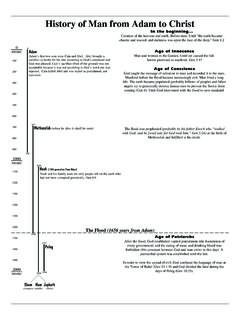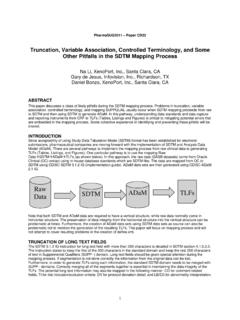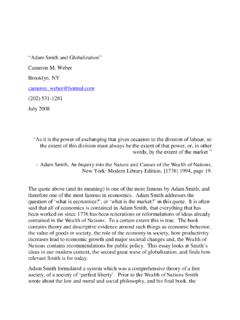Transcription of FROM ADAM TO NOAH: A RECONSIDERATION OF …
1 JETS 37/2 (June 1994) 161!168 FROM ADAM TO NOAH: A RECONSIDERATION OF THE antediluvian patriarchs ' AGES R. K. HARRISON* The narrative material of Gen 5:3!32, which catalogued the ages of the principal descendants of Adam through the line of Seth, has long been a matter for debate, if only because of the apparently exaggerated lifespans attributed to the individuals listed there. Until the rise of rational Biblical criticism in the eighteenth century the lengthy ages were accepted much as they stood, out of deference to the sanc-tity of the divinely!revealed Hebrew tradition. But when literary critics dis-regarded the concepts of revelation and inspiration and began to treat the Hebrew Scriptures as nothing more t h an a collection of national records, of-ten of uncertain provenance and riddled with mythology, a vastly different set of interpretative criteria came to the forefront.
2 Following certain European principles of literary criticism and influ-enced by the notion of supposed human biological evolution, the hypothe-sis developed by Julius Wellhausen (1844!1918) envisioned the growth of Biblical material from rudimentary beginnings until it attained its climax in the late postexilic period (about the second century BC). As far as the Pentateuch was concerned, this approach was worked out in great and of-ten conflicting detail, resulting in the recognition of four supposed basic literary The developed hypothesis was entirely subjective in nature and, as was the case with Darwin's evolutionary views, was entirely untroubled by the exercise of any objective control.
3 Nevertheless external data began to ap-pear in the nineteenth century, and when archeological discoveries brought an entirely new perspective to bear upon ancient Near Eastern studies it became possible for literary!critical procedures to be scrutinized rigorously and to be shown to possess serious flaws in important areas. It is now seen to be no longer appropriate to dismiss the early materi-als in Genesis as either legendary or mythological. Instead it has become important for investigators to recognize these sources as being in conso-nance with analogous Mesopotamian social traditions and records and to assess them accordingly in the light of what is now known about t h at cul-tural background.
4 * The late R Harrison was professor emeritus of Old Testament at Wychflfe College, Uni-versity of Toronto, Canada For a comprehensive survey see R Harrison, Introduction to the Old Testament (Grand Rapids Eerdmans, 1969) 11!32, 495!541 162 JOURNAL OF THE EVANGELICAL THEOLOGICAL SOCIETY For the literary record that preserved data about the antediluvian He-brew patriarchs (Gen 5:3-32) the most obvious object of comparison from Mesopotamia was the ancient Sumerian King List recovered from Kish, especially the predeluge portion of that Dated about 2000 BC, the prism listed the rulers of certain Sumerian cities prior to a devastating flood and assigned to them reigns that were greatly exaggerated in length and that appeared to be of dubious rationality.
5 But when the Hebrew and the Sumerian sources are set side by side it becomes apparent that the large numbers reflect a common if poorly-understood Mesopotamian tradition and that the Genesis tabulation should accordingly be viewed against such a cultural background. Instead of dis-missing it as myth or legend, therefore, the investigator is under an obliga-tion to recognize it as a genuine ancient historical source that was one in intent with the king lists of Babylonia, Assyria, Egypt and the Hittites. In ancient Near Eastern tradition, tabulations of this kind were invari-ably early rather than late in origin, as opposed to Wellhausen's hypothe-sis, and could have had their origins equally in the activities of scribes attached to royal courts, from priests or annalists connected with temple archives, or from privately-commissioned family records.
6 According to the Wiseman-Harrison analysis3 Genesis 5 formed part of the proposed third compositional tablet (Gen 5:3-6:9a), which with a total often such sources comprised l:l-37:2a. That Gen 5:3-32 came ultimately into the possession of Noah and was augmented by contemporary records is indicated by a colophon: "These are the t l d t (narratives, records, family histories) of Noah" (6:9a). In Meso-potamian literary traditions a colophon, which contained material similar to what would occur on the title page of a modern book, formed the conclu-sion of a tablet. To discover the title (if one was extant) of the various tab-lets that are thought to constitute much of the book of Genesis, one had to look backwards to the end of the preceding colophon.
7 Thus in the case of the proposed third tablet the title was probably quite simply "And Adam" (5:3). The chronological materials of Genesis 5 must thus be seen as dis-tinctive to early Hebrew historical tradition, just as the records of the Su-merian King List were to the renowned colonists of ancient Iraq. In an earlier phase of Near Eastern scholarship it was assumed that human culture had developed slowly from primitive beginnings and had reached its apex at a much later date. This notion has now been disabused by the study of ancient Egyptian culture, which arose without any evident precursors in a highly developed stage at the beginning of the Old Kingdom period (c.)
8 2700-2200 BC) and then degenerated until Egypt became part of the Roman empire in 30 BC with the suicide of Queen Cleopatra. While the For t he l i t e r a t u re see A K i t c h e n, Ancient Orient and Old Testament ( L o n d on T y n d a l e, 1966) 38 13, V Hamilton, Genesis Chapters 1!17 ( N I C O T, G r a nd R a p i ds E e r d m a n s, 1990) 2 5 1 !2 5 4, R Harrison, " R e i n v e s t i g a t i ng t he A n t e d i l u v i an S u m e r i an K i ng List," JETS 36(1993) 3 !8 For a d e s c r i p t i on of t h is view see H a r r i s o n, Introduction 64, 5 4 2 !
9 5 52 FROM ADAM TO NOAH 163 cultural decline was slowed temporarily by an occasional interval of re-vival, such as occurred in the New Kingdom period (c. 1570!1095), it was never actually reversed. Similarly it is now known t h at the Sumerians were a highly intelligent people who made basic discoveries in astronomy, mathematics, and other areas of science, reduced speech to writing, and formulated religious con-cepts that influenced human life for many Again there are no attestable historical antecedents t h at would account for this brilliant out-burst of culture upon human society.
10 It is because of the labors of scholars in the present century t h at we are able to marvel at the range of Sumerian discoveries in the arts, religion and sciences. In connection with the latter, so vastly improved is our knowledge of scientific procedures in the ancient Near East in general that it is now possible for scholars to speak in terms of "exact sciences" in that remote On the basis of this background, therefore, it is now proper to assert the probability t h at the apparently unwieldy numbers of the Sumerian King List are in fact accredited schematic mathematical formulations that, when interpreted as such, reveal the means by which they were constructed.
